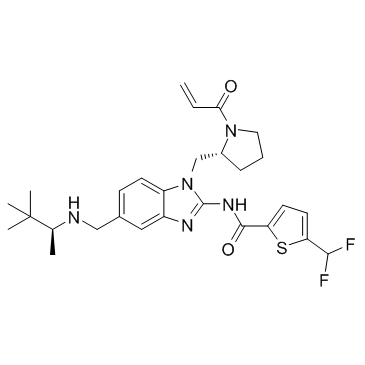1575818-46-0
| Name | PRN694 |
|---|---|
| Synonyms |
N-[(2E)-1-{[(2R)-1-Acryloyl-2-pyrrolidinyl]methyl}-5-({[(2S)-3,3-dimethyl-2-butanyl]amino}methyl)-1,3-dihydro-2H-benzimidazol-2-ylidene]-5-(difluoromethyl)-2-thiophenecarboxamide
K5IZ54DF9G 2-Thiophenecarboxamide, 5-(difluoromethyl)-N-[(2E)-1,3-dihydro-1-[[(2R)-1-(1-oxo-2-propen-1-yl)-2-pyrrolidinyl]methyl]-5-[[[(1S)-1,2,2-trimethylpropyl]amino]methyl]-2H-benzimidazol-2-ylidene]- |
| Description | PRN694 is a highly selective and potent covalent inhibitor of T cell kinase (ITK) and resting lymphocyte kinase (RLK) with IC50s of 0.3 and 1.4 nM, respectively. |
|---|---|
| Related Catalog | |
| Target |
IC50: 0.3 nM (ITK), 1.4 nM (RLK) |
| In Vitro | PRN694 exhibits high potency against ITK and RLK with IC50 values of 0.3 and 1.4 nM, respectively. With PRN694 pretreatment, CD3-mediated CD69 induction is inhibited both in Jurkat T-cells and freshly isolated primary CD4 or CD8 T-cells. Maximal inhibition of CD69 induction is achieved with PRN694 concentrations ranging from 0.1 to 1.0 μM. Immunoblot analysis of TCR activation pathways reveales that PRN694 blocks activation or nuclear translocation of NFAT1, JunB, pIκBα, and pERK. Results reveal inhibition of Ca2+ signaling with PRN694 at all concentrations above 1 nM. The data show that PRN694 significantly attenuates NK cell FcR-induced killing at concentrations exceeding 0.37 μM. Day 6 flow cytometry analysis reveals that PRN694 significantly inhibits the anti-CD3/CD28-induced proliferation of both CD4 and CD8 T-cells (p<0.01)[1]. |
| In Vivo | The PRN694 occupancy of ITK is 98, 95, and 54% at 1, 6, and 14 h, respectively. The concentrations of PRN694 in the plasma are 2.8, 0.66, and 0.027 μM at 1, 6, and 14 h, respectively. At 14 h, the plasma level of PRN694 is over 10 fold lower than the IC50 in whole blood. RN694 treatment also results in significantly lower weights relative to vehicle (p<0.05)[1]. Colitis studies show reduced numbers of CD4+ T cells present in the colonic epithelium of PRN694-treated mice compare with controls[2]. |
| Kinase Assay | Recombinant ITK at a final concentration of 0.5 μM in 50 mM Hepes, pH 7.5, 10 mM MgCl2, 0.01% Triton X-100, and 1 mM EGTA are combined with 1.5 μM PRN694 for 90 min to facilitate binding. The mixture is then diluted 50 fold to initiate dissociating of the ligand from the enzyme, and 10 μL is transferred to a Greiner 384-well black plate. Europium-coupled anti-His6 antibody is added to each well and incubated for 5 min, followed by the addition of an ITK binding fluorescent tracer. The tracer binds to ITK as a function of ligand dissociation, and binding is detected by time-resolved FRET between the europium-coupled antibody and the tracer on a plate reader. Time points acquired are 0.25, 1, 3, 6, and 24 h[1]. |
| Cell Assay | Cells are cultured in vitro at 37°C and 5% CO2 using RPMI 1640 with 10% fetal calf serum. Cells are pretreated for 30 min with PRN694 or other inhibitors and then washed two times. T-cells are then stimulated for 6 h with 1 μg/mL soluble anti-CD3 for CD69 activation, which is detected by flow cytometry, or 45 min with plate-bound anti-CD3 (10 μg/mL plating concentration) and soluble anti-CD28 (1 μg/mL) for downstream signal analysis by immunoblotting. NK cells are stimulated for 6 h with plate-bound anti-CD52 for CD107a/b activation, detected by flow cytometry, or for 45 min for downstream signal analysis by immunoblotting[1]. |
| Animal Admin | Mice are randomized by weight and sensitized with aliquots of 150 μL of 5% oxazolone in 3 parts ethanol and 1 part acetone on their shaved abdomens. Seven days after the sensitization, the mice are challenged with 10 μL of 3% oxazolone on the front and back of the right ears. The left ears are treated with the ethanol/acetone mixture. One hour prior to the challenge, the animals received either vehicle control (5% ethanol, 95% Captex 355 NP/EF, intraperitoneal injection at 5 mL/kg), 20 mg/kg PRN694 in 5% ethanol, 95% Captex (intraperitoneal injection at 5 mL/kg), or 0.5 mg/kg dexamethasone (intraperitoneal injection at 5 mL/kg). A control group of animals receive no oxazolone or drug treatment. Twenty-four hours after the oxazolone challenge, the mice are sacrificed, and a 7 mm disc is punched out of each ear and weighed to measure edema[1]. |
| References |
| Density | 1.3±0.1 g/cm3 |
|---|---|
| Boiling Point | 679.8±65.0 °C at 760 mmHg |
| Molecular Formula | C28H35F2N5O2S |
| Molecular Weight | 543.672 |
| Flash Point | 364.9±34.3 °C |
| Exact Mass | 543.247925 |
| LogP | 3.92 |
| Vapour Pressure | 0.0±2.1 mmHg at 25°C |
| Index of Refraction | 1.619 |
| Storage condition | 2-8℃ |
